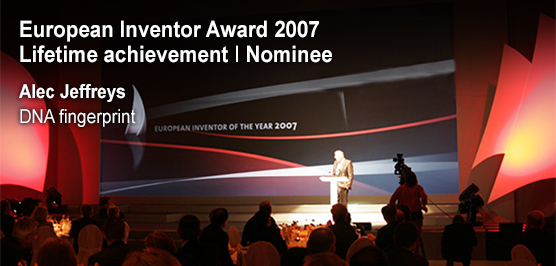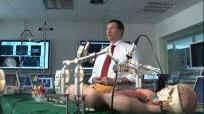Alec Jeffreys
DNA fingerprint
An Unmistakable Sign of Identity
When television audiences watch their favourite crime-scene investigation shows, they already have some clear ideas on how to prove who's guilty. "He probably lost some hair on the scene," the viewers will anticipate, and watch with satisfaction as the killer is identified by matching his DNA with the evidence.
These days, DNA fingerprinting, a patented discovery by British geneticist Professor Sir Alex Jeffreys, has become such a standard procedure in criminal investigation and is so widely known in the public view that even television shows can use the technique for dramatic effect.
Interestingly, though, when looking at the big picture one finds that DNA fingerprinting is a relatively new phenomenon. Though each of us like to think of ourselves as something special - something unique - it was only in the mid-1970s that studies of the human DNA (Deoxyribonucleic acid) showed that we are indeed just that: unique. Every person's DNA - the genetic blueprint controlling the action of every one of the body's 10 trillion cells - shows slight variations that are a signature trademark of every person, making us all different from everyone else.
The big breakthrough came in 1977 thanks to Jeffreys, who was working at the University of Leicester at the time. Amazing in itself, but even more so considering that Jeffreys was only 27 years old at the time.
A graduate of Oxford University, the prodigy studied variations in human DNA, especially those differences observed at highly variable repeat DNA sequences. Through his combination of molecular biology and genetics, he accidentally found that no two strands of DNA are completely alike. Jeffreys essentially came across the individual variations that make every person's DNA one of a kind.
Throughout his career, the now 57-year-old Jeffreys, who still teaches and works at Leicester, has advanced techniques for DNA fingerprinting and registered four patents. Jeffreys also originated methods for DNA profiling, a refinement of the DNA fingerprinting technique. DNA profiling is based on highly variable "mini-satellites" in the human genome. These are select pieces in the otherwise relatively long and complex strand of DNA, where most variations between people occur.
Chasing the bad guys
Most profiling methods these days focus on just a few of these highly variable mini-satellites, which makes the system more sensitive and reproducible. Transferred into coded sequences, DNA profiles are storable in computer databases, where they can be compared and matched with other profiles and samples.
Transferred to the realm of real life in the early 1980s, the technique allowed for groundbreaking improvements in criminal investigations. The first regional screening of human DNA on a broad scale - using saliva samples from men fitting the suspect demographic - was conducted in 1983 after the murder of two girls in the town of Narborough, England.
Since then, DNA fingerprinting has been applied in criminal cases around the world with great success, using blood, sweat, hair or sperm left behind at the scene of a crime as evidence.
Due to the accuracy of DNA profiling, law enforcement agencies around the world have been storing DNA profiles in databases. In case of a crime, suspect data can be screened against these records. The first of its kind, the UK National DNA Database (NDNAD), was launched in Britain in 1995, with similar databases now in operation around the world.
Despite all its advantages, the storage of DNA data for law enforcement purposes has drawn some criticism over the years, especially from Sir Alex Jeffreys himself. As a spokesperson for civil rights groups that advocate every individual's rights to his or her DNA, Jeffreys proposes the creation of an independent agency for storing and securing the sensible data in order to prevent abuse.
This can serve the common good, as the method can be used in many areas outside of criminal investigations. For example, DNA can help identify victims after tragedies such as the Tsunami catastrophe in 2004.
On a day-to-day-basis, DNA evidence is used to settle paternity disputes over who is the biological father of a child, or for handling immigration issues. Since DNA can be obtained and analysed even centuries after a person's death, the technology has helped solve many historic puzzles, including the nationality of Christopher Columbus and the authenticity of the bones of the last Czar of Russia. DNA technology can also be applied in non-human species, for example in wildlife population genetics studies.
Indeed, it's now become impossible to imagine our world without DNA fingerprinting and all that it offers.
How it works
The technique of DNA fingerprinting uses variations in the genetic code to identify individuals. They allow us to distinguish between individuals of the same species using only samples of their DNA. While any two humans will have the vast majority of their DNA sequence in common, there are striking differences in certain parts of the DNA. Genetic fingerprinting exploits these highly variable repeating sequences called "mini-satellites" to establish unmistakable profiles.
Mini-satellites are made of repetitive variant repeats that range in length from 10 to over 100 bp. Due to their high level of polymorphism - meaning widely varied deviations from the norm - mini-satellites have been extensively used for DNA fingerprinting as well as for genetic markers in linkage analysis and population studies.
In preparing the DNA sample (usually saliva collected on a swab) for analysis, a process called Polymerase chain reaction (PCR) is used to create lots of identical DNA out of a small amount. PCR is a molecular biology technique for replicating DNA without using a living organism, instead employing enzymes like yeast and a heat source to stimulate growth.
The most prevalent method of DNA fingerprinting today uses short tandem repeats (STR). This method focuses on highly polymorphic regions that have short repeated sequences of DNA. Because different people have different numbers of repeat units, these regions of DNA can be used to discriminate between individuals.
Contact
European Inventor Award and Young Inventors Prize queries:
european-inventor@epo.org Subscribe to the European Inventor Award newsletterMedia-related queries:
Contact our Press team#InventorAward #YoungInventors



